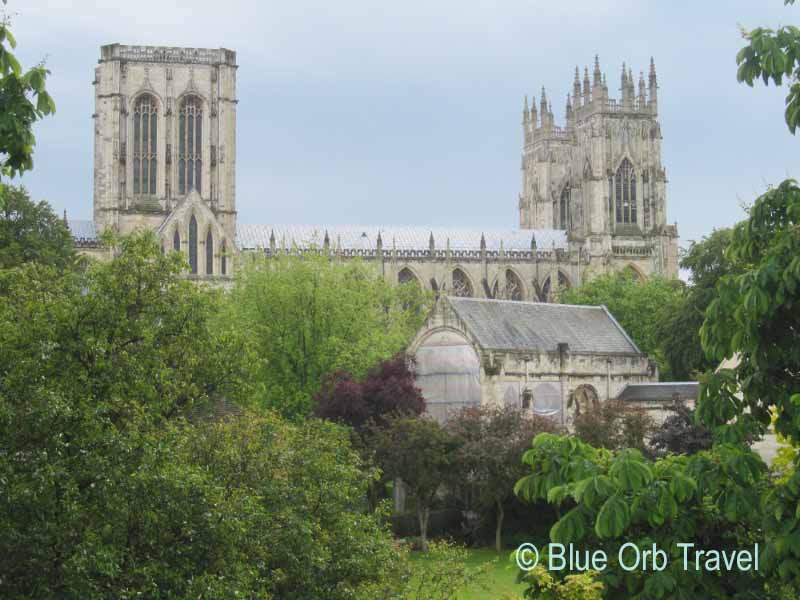A Train Ride Through the Pennines to York, England
My three day sojourn through Wales had come to an end, so on the morning of May 26, I boarded the train at the tiny Conwy station platform bound for York in Northern England. The ticket cost $57 and the five hour ride took us through some interesting cities like Chester, Manchester and Leeds. We then continued on through the beautiful countryside of the Pennines, a low mountain range running north-south, sometimes described as the backbone of England. Known for its outdoor activities, wild life and national parks, this sparsely populated area of England is definitely worth a separate visit, especially since it is traversed in the north by Hadrian’s Wall.

Dogs, Dukes and Pudding
I had never ventured into the Yorkshire counties (there are several) on my previous visits to England, probably because they are somewhat distant from the more ‘touristy’ areas near London. The city of York is actually located in Northern Yorkshire County, which is the largest county in the UK. Before my visit to York, I thought I knew the main things for which the city was known. I knew that Yorkies or Yorkshire Terriers are popular dogs throughout the world, that Yorkshire pudding was made from a baked batter which is usually served with roast beef and gravy, and, of course I knew of the inimitable Sarah Ferguson, the Duchess of York and Prince Andrew, the Duke of York. I was soon to find out that York has much more to offer than dogs, Dukes and pudding.

Two Thousand Years of History
Although there is archeological evidence of early settlers in the area dating back as far as 7000 BC, York was actually founded by the Romans in 71 AD. With nearly two thousand years of recorded history behind its belt, there are reminders of its glorious past almost everywhere the curious tourist cares to explore. Raided by Vikings, captured by William the Conqueror, and burdened by the dubious distinction as the birthplace of Guy Fawkes, York is a treasure trove for the history buff. Surrounded by medieval walls, York is located at the confluence of the River Ouse and the River Foss. It is just a short walk from the train station to the old town walls, beyond which lies a real treat for even the most sophisticated traveler.

The Blossoms York Guest House
Just outside the town walls there are a number of Bed and Breakfast establishments located along Bootham and Clifton Streets, as well as along several other nearby avenues. I found a nice room with private bath including breakfast for $70.00 at the Blossoms York Guest House on Clifton Street, which was about a five minute walk from town. The place was filled with well-behaved children visiting York on a school outing and I enjoyed meeting some of the teachers and chaperones with the group. Internet service was available and free and it was great to be able to connect with home.

Around the Town
Setting out to explore the city by 4 PM, I soon found myself on a circuitous trek around the town at the top of the old medieval walls, descending from this lofty vantage point at intervals along the way to mingle with the crowds and explore the many sights below. Without question, the most prominent landmark in York is York Minster. Completed in 1472, it is one of the largest Gothic cathedrals in Northern Europe. The gorgeous stained glass windows should not be missed and visitors will want to make every effort to get inside to take in the beauty of these remarkable works of art. Nearby is the Treasurer’s House, also dating back to medieval times, with its classic architecture and beautifully manicured gardens.

World Class Museums
There are several world class museums in York, including the Jorvik Viking Centre and the York Castle Museum. Climbing enthusiasts can ascend the steep stairway to the top of Clifford’s Tower, the last remaining vestige of York Castle, for another view of the city below. Visitors will also want to see the Fairfax House dating to the early 1700s and the Roman Baths, recently uncovered beneath a pub. Fans of Harry Potter will enjoy seeing The Shambles, a network of old streets dating back to the 14th century with overhanging wood frame buildings. Astute observers will recognize it as Diagon Alley in the Harry Potter films. Just outside the walls along the River Ouse are the beautiful Museum Gardens with its Norman Abbey ruins. While all of this was easily seen in a few hours on foot, as usual, I left plenty of reasons to return to York someday. The National Railway Museum near the train station will be at the top of that list.




I have been looking for high-quality articles or weblog posts on this kind. Exploring in Yahoo I eventually stumbled upon this website. Studying this information I found out just what I needed. I will make certain to give it a look on a constant basis.